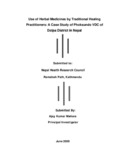Please use this identifier to cite or link to this item:
https://hdl.handle.net/20.500.14356/471| Title: | Use of Herbal Medicines by Traditional Healing Practitioners: A Case Study of Phoksundo VDC of Dolpa District in Nepal |
| Authors: | Nepal Health Research Council (NHRC), Ramshah Path, Kathmandu, Nepal |
| Issue Date: | 2009 |
| Publisher: | Nepal Health Research Council |
| Keywords: | Herbal Medicines Traditional Healing Practitioners Dolpa District |
| Abstract: | In Nepal, traditional healing practices play a strong role in maintaining psychological and physical well being of the majority of rural people who do not have access of satisfactory modern health services. Most of the medical doctors prefer towork in urban areas where they get more opportunities. The modernhealth services are not accessible to the population of rural areas. The practices of healing of rural people are beyond the proper access of modern health center, health worker and health education. Traditional healers and locally available medicinal plants play vital role in the lives of the rural peoples. The situation of traditional healing of the people of the Dolpo is not different from the rest people of the country, people of the Dolpo region prefer to consult with Amchis, the local traditional healers. A study on "Use of Herbal Medicines by Traditional Healing Practitioners: A Case Study of Phoksundo VDC of Dopla District in Nepal” hasalone to fulfill the objectives to find out the use of different healing practices inthe selected areas as well as to identify the factors related to use of the healing practitioners and their herbalmedicines by the community peoples. Beside these, this research also tries to ascertain the measures taken topromote the traditional healing practices and sustainable use of herbal medicines. Out of 99 households, 30 percent (i.e. 30 households) were selected by using proportional stratified random sampling Procedure. Data was collected from the selected household head using questionnaires. Data were tabulated in a chart to prepare analytical tables under different headingsand sub-headings. Interpretation was made on the basis of percentage, causes count and comparing with other variables. Majority of people had positive attitude on traditional healing practices. In their opinion, it was cheap, locally available and regular service, that’s why they went to the traditional healing practitioners for their treatment. On the basis of the interview taken with the people of village, this present study tries to givesuggestions to the government, and to the concerned NGO, INGO and other social institutions. It tries to give suggestion to them about training to the traditional healing practitioners about health education, self-awareness and encourage them to use modern health service and provide them with the facilities to easy access of the herbal plants. |
| URI: | http://103.69.126.140:8080/handle/20.500.14356/471 |
| Appears in Collections: | NHRC Research Report |
Items in DSpace are protected by copyright, with all rights reserved, unless otherwise indicated.

